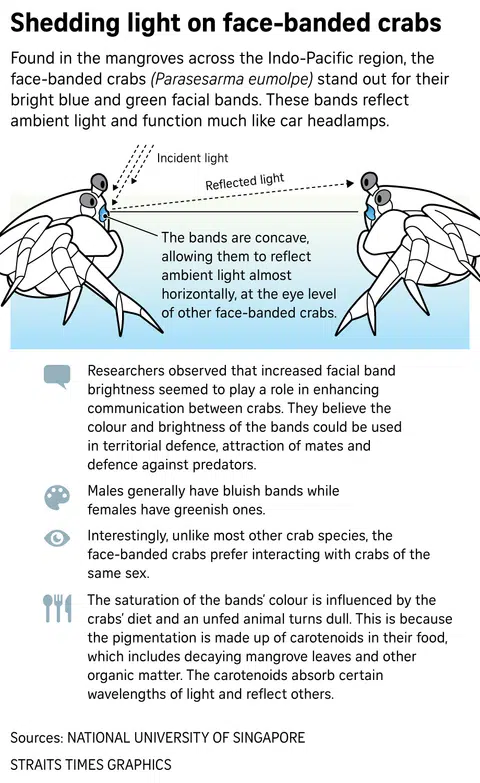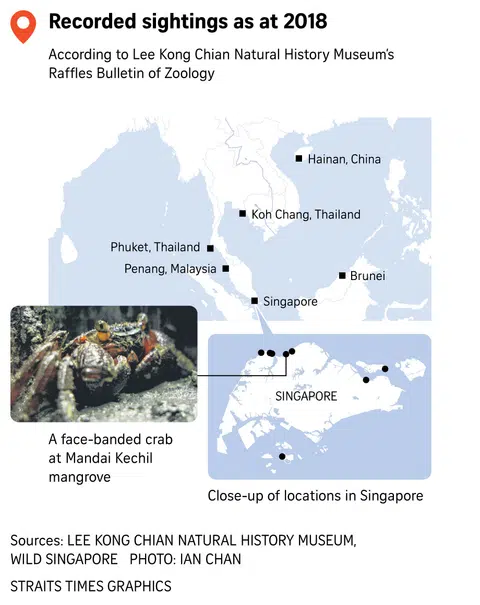NUS researchers discover what's behind the electric blue strip on local mangrove crab
A black mangrove crab peers from a muddy bed of fallen leaves in Mandai Kechil, its striking cyan "monobrow" set in an alien-like glare.
The piercing blue strip on the face-banded crab (Parasesarma eumolpe) is neither bioluminescent - it does not glow in the dark - nor iridescent, meaning that its colours do not shift at different angles.
Instead, researchers here have discovered, it is the band's concave shape that focuses reflected light to enhance brightness, much like the reflective surface behind the bulb in car headlights.
What is more, no matter what angle the source light comes from, the crab's band reflects light most intensely at the eye level of other face-banded crabs to optimise signalling, or conveying information about itself.
The face-banded crab - a small freshwater crustacean with a shell typically between 2.5cm and 4cm wide commonly found in Singapore, Malaysia, Indonesia, Thailand and China - has been the focus of over a decade of research by scientists from the National University of Singapore (NUS).
NUS researchers Peter Todd and Ian Chan, from the university's Department of Biological Sciences, believe this is the first known example of such light-focusing external structures used for signalling in animals.
Their new study, co-authored with four other researchers from the department, details the band's structure that they term "nature's headlamps" - finally shedding light on the mystery behind its luminance and brightness.
Similar reflective features have previously only been documented in the eyes of animals, like dogs, cats and crocodiles, but these enhance vision in the dark and are not used for signalling.
"It is exciting that such a structure has evolved to enhance signalling in these crabs but has not been described previously," said Associate Professor Todd.
Face-banded crabs are not difficult to spot even in a dim environment owing to their ability to reflect and focus even the most limited amount of ambient light that falls on it, he added.
The study found that increased facial band brightness seemed to play a role in enhancing communication between individual crabs.
"Our results seem to suggest that the crabs are able to use both colour and brightness components of visual signs as separate sources of information," Prof Todd said.
He added: "We cannot say what information is communicated, but we suspect it may be related to territorial defence, attraction of mates, or defence against predators."
The face-banded crabs sport two distinct coloured facial bands. Male face-banded crabs tend to possess blue bands, while the bands of females skew green.

Prof Todd's laboratory had previously identified that the blue and green colouration observed in the bands of the face-banded crab was the result of carotenoids in the crabs' diet - mainly decaying mangrove leaves and other organic matter - rather than structural colouration.
Carotenoids are chemical pigments that absorb certain wavelengths of light, while reflecting other wavelengths out, and are found in most plants, algae, and animals that consume these plants and algae.
For example, the vibrant plumage of flamingos is the result of a diet rich in algae and brine shrimp.
With the crabs, the bands fade when they are starved, but brightens when the crabs are fed again, suggesting that the vibrancy provides cues of the crab's physical health.
Structural colouration, on the other hand, like in the wings of butterflies and feathers of peacocks, is caused by microscopic physical structures that reflect hues that shift depending on the viewer's angle.
The study involved recording the interactions between 30 male and 26 female face-banded crabs in their native habitat at Mandai Kechil mangrove in Singapore.
A challenge the researchers faced was in getting the probe of the reflectance spectrometer - a tool used in calculating the amount of light bouncing off a surface - close enough to get a good reading of the bands' reflectivity at varied angles.
"The probes may be a few millimetres in diameter, but the face band is even smaller, and there were no thinner probes we could buy off the shelf to resolve this," Prof Todd explained.
His solution: stripping the probes to expose the fibre-optic cable housed within, and then cutting and polishing the ends of the cables so that they were small enough to get within a millimetre or two of the face bands. These cables transmitted light from the machine to the crabs, and read the amount of light being reflected.
Prof Todd, who had previously studied crab colours and patterns in Britain, began research on the face-banded crab in Singapore in 2007.
Since publishing a first paper on these crabs in 2008, where his team measured the colour of the bands, he has led researchers through novel experiments to learn more about this intriguing species.
One such experiment involved painting some crabs with a non-toxic, washable black paint, to determine if the colour of the bands affected interaction between crabs.
He first placed two crabs into an arena he made within the mangrove and observed their behaviour, before blacking out a crab's band, and returning them to the enclosure.
"When you black out the face bands, the behaviour changes dramatically. The guy without a blacked-out face band is no longer interested in the one whose band is blacked out," he said.
The paint was then removed, and the crab was once again placed in the arena, where the interaction between the two crabs was observed to return to normal. This suggested that the crabs are interested in the coloured bands.
This latest study also documented a previous controlled experiment Prof Todd and his team conducted, where images of two face-banded crabs - one with a brighter facial band than the other - were presented to a live crab.
Both male and female test specimens were observed to gravitate towards the image with the brighter band, noted Prof Todd.
This also suggested that the brightness of the facial bands enhanced the crabs' ability to transmit visual signals.

An interesting observation made was that the crabs seemed to demonstrate an attraction for the same sex, approaching crabs with facial bands of the same colours, though the reason remains unknown.
A closely related species of crab does the opposite, Prof Todd said.
"Usually when crabs approach individuals of the opposite sex, it has got something to do with sexuality... But if they are approaching the same sex, then it might be related to competition for mates or resources instead."
Next, the team plans to further pursue research on what is being communicated with the bands.
Dr Chan said: "What we show in this paper is a more fundamental type of discovery, that is so exciting on its own."
He added: "In science, we must always have more questions when we find answers. But these questions, though important and which may advance behavioural ecology, are not as big as what we've just discovered with these structures."
Zachary Lim for The Straits Times